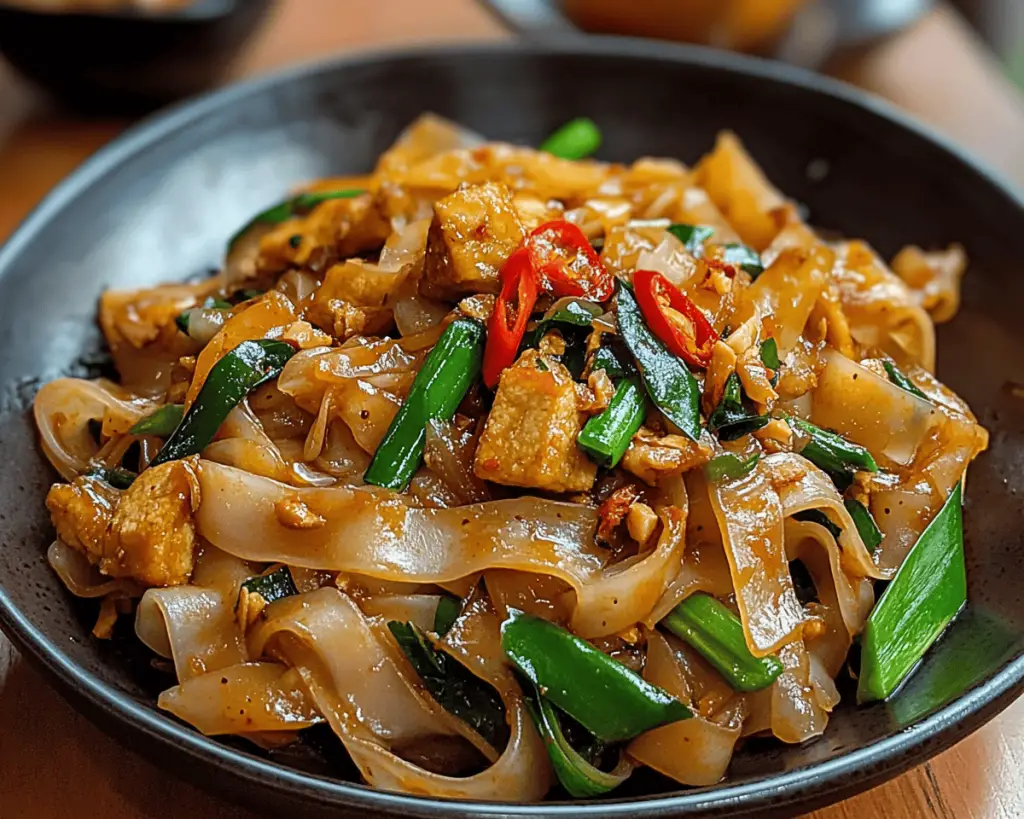As I think back to my first encounter with Thai Drunken Noodles, I can almost taste the raucous nightlife of Bangkok, where spicy flavors tumble into one another, igniting the senses. The first time I experienced these indulgent noodles was during a spontaneous trip to Thailand with my college friends. We were fresh out of class, buzzing with youthful energy and hungry for adventure. As we drifted through the night markets, the air rich with the scent of sizzling woks and spices, I stumbled upon a street vendor handing out steaming bowls of flat rice noodles, glistening in a spicy brown sauce.
The vendor leaned over the steaming pots, expertly tossing the ingredients in his wok, throwing in a handful of basil with a flourish that made me believe he had been performing this ritual for decades. I remember the sound of the oil sizzling, mingling with the vibrancy of chatter and laughter from people who had gathered around. That dish was a revelation; a meeting of textures and flavors that seemed to dance around my taste buds. Hot, sweet, and savory all at once; it was like an embrace I didn’t know I needed.
It became a staple for me and my friends, the ultimate comfort food after a long day of exploring—or perhaps the perfect fuel for a late-night out. Our laughter would echo through our shared apartment as we tossed back enormous helpings of drunken noodles, a ritual that became part of our friendship. Each bite was a reminder of those carefree days, and as we prepared the dish together, it naturally morphed into our own version of comfort—I remember the first time I made it alone, scared that I would not capture the magic we had shared.
But the secret ingredient of my version came not just from the recipe, but from the memories layered in each bite. Over the years, I’ve played with the dish—adjusting flavors, adding a twist here and there—but the essence of that street-style flavor has remained a fond and cherished part of my cooking. Each time I prepare it, the experience feels like a homecoming.
Inside the Ingredients of Quick and Flavorful Street Style Thai Drunken Noodles
Let’s take a closer look at the ingredients that come together to create this vibrant dish. Each one plays a crucial role, not just in flavor, but in the memories and experiences tied to them.
Flat Rice Noodles: The canvas of this dish, flat rice noodles—often referred to as “sen yai”—bring a chewy and satisfying texture that captures all the delicious sauce. They are often soaked rather than boiled, which can make a world of difference. Try to find fresh noodles if you can; they have a pliability that dried varieties just can’t replicate. But if convenience is key, the dried noodles work just fine! I always keep a stash in my pantry for those nights when a craving ignites.
Vegetables: Feel free to be generous with vegetables. I’ve encountered everything from bell peppers to broccoli in various adaptations, but my personal favorite combination is bell peppers and baby corn. The crunch they provide is a good counterpoint to the softer noodles, making each bite more exciting. It is a simple yet nourishing way to incorporate fresh ingredients, grounding the dish amidst the bold flavors.
Protein: Traditionally, drunken noodles are made with chicken or shrimp, but I’ve also whipped up vegan versions with tofu, or even kept it simple with just vegetables when I want to lighten things up. The main goal is to ensure that whatever protein you use can absorb those bold flavors, as they work synergistically with the rest of the dish. I’ve learned that marinating the protein briefly in soy sauce, garlic, and maybe a touch of sugar elevates the flavor, setting up a wonderful base.
Basil: No drunken noodles can attend the party without Thai basil, which is aromatic and slightly spicy compared to its sweet cousin. It carries an exhilarating fragrance that transforms the dish entirely. Whenever I’m here chopping the leaves, I can feel that instant connection to those markets in Bangkok; it’s my sprinkle of nostalgia. If you can’t find Thai basil, holy basil is a fantastic alternative, bringing its own unique spin to this vibrant dish.
Chili Paste: Enter the magic of chili paste. This component ties everything together and gives it the spicy kick we associate with drunken noodles. When selecting a chili paste, I often opt for one with a bit of sweetness to achieve a balanced flavor. It’s one of those elements that can truly make or break this recipe, so I recommend playing around with the amount to dial it up or dial it down based on your personal heat tolerance. For me, it’s like adding a dose of excitement into my evening!
Soy Sauce: Not just any soy sauce will cut it here; a dark variety lends richness and saltiness that rounds out the dish’s overall flavor profile. And let’s not forget—good, aged soy sauce even brings with it that umami depth we crave in many Asian dishes. I find myself uncharacteristically protective over my soy sauce choice; it can be wondrous how one product can define an entire dish.
Oyster Sauce: Often underrated, oyster sauce magnifies the deliciousness through its savory, slightly sweet taste. It adds a glossy finish that makes the noodles irresistible. I remember being hesitant the first time I used it, but its depth of flavor gives me the confidence to keep it on hand.
How Quick and Flavorful Street Style Thai Drunken Noodles Fits Into a Balanced Life
At first glance, a plate of drunken noodles might seem like a late-night indulgence, but with mindful choices, it can beautifully fit into a balanced lifestyle. The vibrant colors, the crunch of the veggies, and the chewy noodles exemplify how nourishment can coalesce with pure joy.
In terms of nutrition, this dish can be remarkably wholesome. You’ve got your source of carbs from the noodles, protein (from your chosen meat or tofu), and a medley of vegetables that help round out the meal. I often remind myself that food isn’t just about the grams of protein or carbs or fats; it’s about the energy it brings and the memories made as you enjoy it. This allows for the enjoyment of flavor while still feeling good about what I’m putting into my body.
This is where adaptability becomes important. You can embrace the joy of drunken noodles while customizing it to meet various dietary needs—going vegetarian or gluten-free is as easy as substituting the protein and opting for gluten-free soy sauce and rice noodles. You can throw in any vegetables you have lurking in the fridge, embracing the recipes’ lively nature while minimizing waste.
For me, drunken noodles have seen me through various life phases, whether it was during my break-up comfort food binge or celebratory gatherings with friends where laughter filled the air. In each iteration, I learned to embrace the notion that food should evoke emotions and memories, rather than counting calories or nutrients obsessively. There’s a power in a dish like this; a reminder that nourishment can ignite joy and connection without any guilt.
What You’ll Need
– Flat Rice Noodles: 8 ounces
– Vegetables: 1 cup (sliced bell peppers, baby corn, or your choice)
– Protein: 1 cup (chicken, shrimp, or tofu)
– Thai Basil: 1 cup (fresh, chopped)
– Chili Paste: 2 tablespoons (adjust to taste)
– Soy Sauce: 2 tablespoons
– Oyster Sauce: 1 tablespoon
– Garlic: 3 cloves (minced)
– Oil: 2 tablespoons (cooking or vegetable oil)
– Optional Garnish: Lime wedges and chopped peanuts
This serves about 3–4, depending on your appetite!
Preparing Quick and Flavorful Thai Drunken Noodles Step by Step
Ah, here comes the fun part—the cooking! Nothing brings memories to life quite like the process of putting together a beloved dish.
First, let’s start by soaking the flat rice noodles in warm water for about 20 to 30 minutes until they’re soft and pliable. Don’t panic if they feel a bit mushy—trust me, they’ll cook wonderfully in the next steps. I often get distracted during this waiting period, perhaps washing up or gathering other ingredients, but that time is essential for noodles that deliver that perfect chewy texture.
Once they’ve softened, drain the noodles and set them aside. It’s time to heat up a splash of oil in a large skillet or wok over medium heat. This is the moment we get to unlock flavors—add the minced garlic and toast it for just a minute or so until you’re enveloped in that aromatic garlicky wave. Don’t rush this part! Take a moment to bask in the smell; it’s like a warm hello inviting you to gather around.
Next, toss in your chosen protein and stir-fry until it’s browned and cooked through. If you’re using tofu, I often like to press and cube it beforehand for the best texture, adding layers of crunch and flavor. Once your protein reaches golden perfection, pull it to one side of the pan, making space for the vegetables.
It’s time to add in your vibrant medley of vegetables. The trick here is to keep them somewhat crunchy—so just a few minutes of direct heat will suffice. I’ve found baby corn maintains fabulous texture without going mushy, and those sliced bell peppers are as delightful as they are colorful, filling the pan with life.
Now it’s time for the star of the show: toss in the chili paste, soy sauce, and oyster sauce to coat your ingredients, reveling in that sizzling sound of flavors melding together. Ah, this is where you may want to make adjustments—taste as you go; life is too short not to enjoy your food, right?
Once everything is gloriously coated, gently fold in the soaked rice noodles until they’re embraced by the colors and flavors surrounding them. The soft noodles will absorb all that glorious sauce, becoming flavorful carriers of the stories you share around the table. You’ll want to simmer for a few minutes, letting the ingredients get friendly with the heat.
Finally, just before serving, sprinkle a generous handful of Thai basil on top. This is a must; the fragrance alone transports me back to bustling Bangkok. A quick stir and it’s ready to be plated, with lime wedges and chopped peanuts for a bit of an extra punch.
Lessons from My Kitchen
Throughout the years spent preparing Thai drunken noodles, there have been numerous kitchen lessons, some humorous, others ever so humbling. I can’t recall how many times I’ve mistakenly pulsed a heaping spoonful of chili paste, only to wind up coughing, and dashing toward the fridge for yogurt to cool my mouth. Measurement tends to go out the window for me when I’m rushing to deliciousness!
I discovered that the temperature of the pan matters significantly. A pan that isn’t hot enough results in sad, soggy noodles. But when the heat is just right, everything comes together beautifully, becoming a glorious harmony of colors and flavors. Sometimes I even question my entire existence because I’ve rushed it—only to realize, patience blooms flavor.
Another lesson came when I tried switching it up with seasonal vegetables—brussels sprouts in winter felt like a culinary leap of faith! It was delicious but making me realize that it’s all about adapting to what you have available. Cooking doesn’t need to be rigid; it celebrates creativity and improvisation.
As I’ve grown in my cooking, I’ve incorporated quotes that inspire me. A dear friend once told me, “Cook with love, and the flavors will follow.” I often recite that mantra as I dive into preparing these drunken noodles, letting feelings in every step become tangible.
What’s essential is forging connections around food—not just the act of making it, but sharing it with the people you love. So whether you’re cooking for one or a crowded table, each batch of drunken noodles brings with it a world of memories and the opportunity to make new ones.
(Closing Thought)
Thai drunken noodles have journeyed with me through years of life—celebrating the highs, comforting during the lows, and embracing flavors so vibrant that they echo stories throughout. In the rush of everyday life, I always remind myself—slow down and savor every moment, just as we’d savor each fragrant bite of these noodles.
I hope you too will enjoy crafting your own version, inviting that warmth and connection into your kitchen. Let this dish celebrate the bond of sharing, both with friends and yourself, and become a little portal to places and memories that always bring you back to joy.



